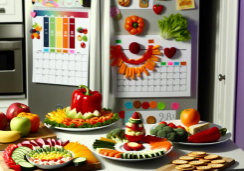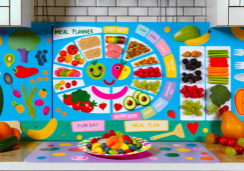Smart Meal Planning Tips for Diabetes Control
Have you ever considered how strategic meal planning could become your most powerful ally in controlling diabetes? When you live with diabetes, every food choice matters, and it's not just about avoiding sugar.
A smart approach to meal planning can help you maintain steady blood glucose levels and manage your weight, which are both critical aspects of diabetes management. You'll need to understand how different foods affect your blood sugar and find the right balance of carbohydrates, protein, and fats.
But how exactly do you create a meal plan that's both satisfying and beneficial for your health? Stay tuned to uncover practical tips that can transform your daily routine and empower you to take control of your diabetes through thoughtful meal planning.
Understanding the Diabetes Plate Method
To effectively manage your blood glucose levels, it's helpful to utilize the Diabetes Plate Method, a simple approach to creating balanced meals without the need for meticulous counting or measuring. This easy and effective strategy endorsed by the American Diabetes Association, allows you to control your blood sugar by visually dividing your plate to include a variety of food groups.
Here's how it works: fill half of your plate with non-starchy vegetables, such as leafy greens, peppers, or broccoli. These are packed with nutrients and have a low glycemic index, meaning they won't spike your blood sugar.
A quarter of your plate should contain lean protein, like chicken, fish, or tofu, to manage blood sugar and support muscle health.
The remaining quarter is for carbohydrates, preferably from whole grains or other foods that include fiber, to help moderate blood sugar levels.
Balancing Macronutrients Intelligently
Mastering the balance of macronutrients in your meals can significantly enhance your blood glucose management and contribute to overall health. By strategically including vegetables, proteins, and carbohydrates, you're setting the stage for more stable blood glucose levels. The plate method, discussed earlier, is an easy way to proportion your meals without obsessing over counting or measuring.
For proteins, consider healthy options like lean meats, fish, eggs, and plant-based proteins. These foods with low fat content support blood sugar control and can be delicious, too—think grilled chicken, baked salmon, or a veggie omelet. Pair them with high-fiber carbohydrates, such as whole grains, fruits, and vegetables. These choices have a lower glycemic index, which means they're less likely to spike your blood sugar.
Incorporate foods like plain Greek yogurt for a low-fat, protein-rich snack, or add a spoonful of peanut butter to a slice of whole-grain bread for sustained energy. Aim to eat balanced meals spread out over three meals a day to keep your metabolism and blood sugar levels in check.
Timing and Consistency in Meals
Establishing a routine where you eat meals at the same times each day can play a crucial role in keeping your blood glucose levels steady. With diabetes, your body's ability to regulate blood sugar levels is compromised, making the timing and consistency in meals vital to your management plan. By eating at regular intervals, you prevent the dangerous spikes and dips that can occur when meals are skipped or delayed.
Consistency not only helps to keep your blood sugar levels low but also aids in weight loss and overall health. To maintain this stability, plan your meals with the help of a dietitian, who can guide you in selecting the right foods in appropriate portions. Utilize the plate method to ensure a balanced diet—fill half your plate with vegetables, a quarter with lean protein, and a quarter with whole grains or starchy foods. Add in small portions of fruits and low-fat dairy for a well-rounded meal.
Remember to check your blood sugar levels regularly to see how your meal schedule affects them. Drink water, coffee, or tea without added sugar instead of sugary beverages to further help manage your diabetes. Sticking to a meal planning routine can significantly enhance your ability to control your condition and lead a healthier life.
Portion Control Strategies
Getting a handle on portion sizes is essential for managing diabetes, as it helps prevent overeating and maintains balanced blood sugar levels. One effective method is using the plate method to ensure you're getting the right balance of vegetables, protein, and carbohydrates. This way, you can create meal plans that are both satisfying and healthy without needing to count every calorie.
Incorporating more low-carb meals into your Diabetes Diet can significantly help manage your blood sugar. Learn to read food labels to grasp how different foods and their portions impact your blood glucose. This knowledge is a powerful tool in your portion control strategies and can help you make informed decisions about what to eat.
For people with diabetes looking to lose weight or maintain a healthy weight, starting small can lead to big changes. Swap out sugary drinks for water and gradually add more fruits and vegetables to your meals. These simple swaps can help keep your blood sugar in check and support your weight management goals.
Incorporating Low GI Foods
While learning to control portions is a significant step, integrating low glycemic index foods into your diet is another effective strategy for managing your diabetes. Opting for whole grains, legumes, and non-starchy vegetables can make a significant difference in maintaining steady blood sugar levels. These low GI foods result in gradual increases in blood glucose, rather than the sharp spikes associated with high GI foods like white bread, white rice, and russet potatoes.
When planning your meal plans, focus on foods that aren't only low GI but also low in fat and rich in nutrients. For instance, adding a medium apple or some bell pepper slices to your lunch can provide the sweetness or crunch you crave without jeopardizing your blood sugar control.
And when it comes to snacks, reach for options like nuts, seeds, or Greek yogurt—these not only support your blood sugar goals but also contribute to your overall health.
Frequently Asked Questions
What Should a Diabetic Meal Plan Look Like?
Your diabetic meal plan should focus on balanced macronutrients, portion control, and carb counting for glycemic management. Include diverse vegetables, varied protein choices, healthy fats, and consider nutrient timing and hydration importance with mindful snacking.
What Is the Best Eating Schedule for Diabetics?
You'll manage your diabetes best by eating regularly, controlling portions, understanding the glycemic index, and balancing nutrients. Monitor blood sugar, stay hydrated, limit snacks, avoid emotional eating, exercise, and sync meals with medication.
What Smart Foods Are Good for Diabetics?
You'll benefit from blood sugar balancing foods like low glycemic index veggies, fiber-rich fruits, and healthy fats. Master portion control, carb counting, and choose lean proteins. Hydrate well and snack smartly on antioxidant sources.
What Is the Best Food Chart for a Diabetic Patient?
Your best food chart includes low Glycemic Index items, emphasizes Carb Counting, teaches Portion Control, ensures a Balanced Plate, focuses on proper Food Pairing, highlights Nutrient Density, suggests Sugar Alternatives, and promotes smart Snack Choices.
Conclusion
In conclusion, you've got the tools to manage your diabetes effectively. By using the Diabetes Plate Method, balancing your macronutrients, and eating consistently, you'll keep your blood sugar stable. Remember to control your portions and choose low GI foods.
Stick to these strategies, and you'll be in control. It's all about making informed choices and seeking support when needed. Start small, and you'll see big changes in your health.
Stay proactive and empowered in your diabetes management journey.










